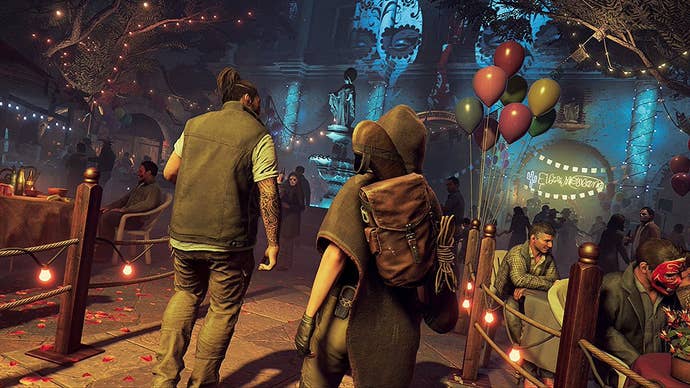In Shadow of the Tomb Raider, Lara Croft's Selfish Tomb Raiding is Bad
The human cost of Lara's quest for ancient artifacts is finally laid bare in Eidos Montreal's latest action-adventure.
This article first appeared on USgamer, a partner publication of VG247. Some content, such as this article, has been migrated to VG247 for posterity after USgamer's closure - but it has not been edited or further vetted by the VG247 team.
There's an offhand comment in the early goings of my demo of Shadow of the Tomb Raider where a foe reports to keep a look out for Lara Croft, a caucasian woman in her early 20s. At this point Lara's sneaking around in disguise (she's wearing a hoodie and a Día de los Muertos mask—the setting is in a small village on the island of Cozumel, Mexico). It's a culturally loaded sequence, but in addition to that, one thing that stuck out to me was her age: early 20s. When I got back to my hotel later that night, I read that Lara and I were born in the same year: 1992. Huh.
Being a girl in her mid-20s is a weird time. I feel like I'm 25 going on 30 at this point, even if I still have about half of my 20s ahead of me. I imagine for Lara, someone who's kicked more ass in her lifetime (and many alternate lifetimes) than nearly anyone, it must be an even weirder time. And with all those accomplishments, tragedies, uprooted cultural artifacts, and dead bodies left in her wake, she's understandably cocky. She's brash. She acts without thinking of the consequences. Essentially, she's a big dumb idiot. (I can relate on that point.)
And that's what Shadow of the Tomb Raider is about. Big dumb idiot Lara Croft realizing that she should stop thinking about only herself all the time.

The cinematic trailer, released earlier this morning, shows that foolishness plain as day. Here we see Lara killing soldiers in a jungle as she narrates. The trailer cuts back and forth with a Mayan sacrificial ceremony as she wonders out loud, "After all I've sacrificed, what will I become?" In the sequence, she then interrupts the ceremony, in her eyes "saving" the young boy about to be sacrificed. He winces at her offer for help, and when she stumbles forward confused and injured, she sees an entire city of people gazing up at her from the ground below. Lara's white savior act was probably a bad idea.
"The feeling we have from that [moment in the trailer], that's Lara's greatest fear," Narrative Director Jason Dozois tells me at the Shadow of the Tomb Raider reveal event at The Mayan theater in Los Angeles. "And if she keeps going on the road that she's on, not understanding and just reacting, she fears she's going to become that." That, meaning, a person who doesn't consider others' cultures; a person who acts without thinking things through; a person whose already-existing narcissist tendencies get worse.
The new Tomb Raider will largely take place across South and Central America, as Lara chases a hidden Mayan city deep within it. The description for the game's plot elicits a chuckle, with Lara on the journey to "stop the Mayan apocalypse"—Lara's come a long way from chasing her dad's old mysteries. "We picked the Maya because the Maya were really concerned with time and astronomy," Dozois says. "So the clue at the beginning, that will lead to Peru on those dates with those constellations. If you follow that, that's an actual thing that will lead to these locations." The Eidos Montreal team also consulted with cultural experts for the game. In fact, that very disclaimer was the very first thing that greeted me when I launched the demo.
Yesterday at the reveal event for the third entry in the Tomb Raider reboot series, which promises to be the finale for Lara Croft's origin story, I played about an hour of Shadow of the Tomb Raider. It's the first of the new Tomb Raider games to have Eidos Montreal at the helm, swapping the usual relationship of Eidos aiding Crystal Dynamics along its development.
The demo I played seemed to be in an early portion of the game, and unfortunately didn't really play to the series' strengths, leaning on linearity and climbing, with minimal stealth combat and puzzle solving. The start pins players in Cozumel, Mexico during Día de los Muertos, tracking the criminal organization Trinity and attempting to beat them in a race: a race to another ancient artifact. But Lara's sly about it and only stealthily murders just two men before she dives deep underground.

It's the set-up we've seen many times before in adventure games and movies. Lara's after an artifact, but the trouble is, so are the militant bad guys with guns. Lara's essentially a one-gal crew (or two, if you count her old pal Jonah, though he usually stays out of combat's way). Everyone's terrified of her, because she's a killing machine—she can even blend in with vines on walls now. She has more in common with Rambo now than she ever did with Nathan Drake.
The high point of the demo came in its underwater sequence, a return to form for the franchise as a whole. The sequence is tense, and reminded me of the brutal feelings the 2013 Tomb Raider game in particular emoted. As Lara swims through the deep underwater cave, you hear her begin to gasp and struggle—and as the player, your task is only to guide her toward the light as quickly as possible. Sometimes the light is a small hole where she can reclaim her breath, sometimes it's something more nefarious like an eel.
The demo gets turned on its head once Lara reaches her destination. Hearing her foes up above blasting their way into the area (side note: isn't this every villain's solution in every adventure game?), decides to grab the Mayan dagger in a last minute decision. The place starts crumbling because of course it does, and she escapes. She emerges from the rubble to do what she does best: kill more dudes. And then, she lets her guard down, has the super special dagger taken away from her, but not before the "villain" scolds her a little bit for removing the dagger in the first place. She's told that she's essentially initiated the Mayan apocalypse with this mishap, and now it's his job to "clean up" the mess she's made.
Lara, being Lara, doesn't seem like she believes it—even when an unexpected tsunami swoops in to destroy the nearby village and take her along with it. After some nasty impalements due to timing a few jumps poorly (oh yes, grisly death animations are back, baby), Lara's back with her friend Jonah, who's busy helping locals affected by the mess. The two have an argument after Lara insists they leave and chase down Trinity who are now in possession of the dagger, likely believing the tsunami to possibly have been caused by the ancient artifact's removal. Jonah operates as the realist: Lara's being selfish, and the people here need help urgently, and the game of cat and mouse with Trinity can wait. Lara pouts.

The exchange illuminates something Lara's missing—the part she was told about the mess she made, and how her enemies were now on their way to clean it up. She's the one who probably caused this, if mythical tall tales are to be believed. My first thought, as Lara gazed out at the wreckage of the village that was just having a lovely cultural celebration of their deceased loved ones before it was washed away, is that Lara sucks. Lara, obviously, is the villain here. And that seems to be the key that sets apart Eidos Montreal's entry into the series from its predecessors. That, and the fact that there will be actual in-game people Lara can talk to in some of the hub areas.
"There's more of a social experience you're going to experience for the first time in [this] Tomb Raider game," Lead Game Designer Heath Smith tells me. "This Tomb Raider actually has the largest hub spaces of any Tomb Raider, but it's full of people and this is a challenge that Lara hasn't faced before in the franchise. This is something we're really excited about and we feel this is one of the strengths of Eidos Montreal that we can bring to the franchise [compared to the Crystal Dynamics-developed predecessors], it gives it a unique flavor." It sounds like Lara has to learn some people skills in addition to whatever bow she wields, too.
All signs are pointing to Lara growing out of her big dumb idiot phase. Since this is the end of her origin story, she'll likely learn some lessons, apologize for being a jerk, and still save a secret city of Mayans for something she inadvertently caused. Dozois assures me that's the intent: to have Lara actually learn from her mistakes. "What we're trying to have her learn [is] that tomb raiding in the wrong context can be destructive, like her taking the dagger, she doesn't know but then she's bringing on horrible things that have a human cost." Considering the boy I saw seemingly fall to his death in the demo as I was climbing along an edge with no problem, that's a pretty high cost to pay for a shiny dagger, Lara. Shadow of the Tomb Raider will be out on September 14, 2018 for PlayStation 4, Xbox One, and PC.
Edit: We were up pretty late writing this due to the quick turnaround for embargo, and made the mistake of saying the hidden Mayan city Lara is in pursuit of would be in Peru, when it was not confirmed where it will be located (though Peru will be a major location in the game). We've edited the story above to reflect this and regret the error.


















